Are you doing Malasana ( garland / squat pose) pose ? Lets’ have a look at it’s benefits.
As we all know about the old Indian traditional system that, Indian people are very touched with the yoga and yoga poses in day-to-day life.
Traditional Hindu system architecture in India is totally scientifically design, which also includes Indian toilets. Now this has been overtaken by western commodes and as an effect of this, so many people are now complaining about constipation, IBS, sciatica, backpain, anxiety and many more. Are you one of them?
Then Malasana is for you. Why?…because this is a famous yoga pose which will relieve all your physical and mental issues if you will practice it regularly.

Malasana with Ayurveda perspective:
Mala means waste product as per Ayurveda there are 3 main waste products :feces, urine and sweat.
Relation with dosha:
Feces and urine are two waste products that come under Apan Vayu (the downward direction of vata dosha) which improves the lower body portion organs and its functions like menstruation, defecation, urination and reproduction. Malasana keeps Apan Vayu activated and energetic.
This is downward flow of prana that is Apana Vayu. Malasana helps to balance saman Vayu, Apan Vayu and Pachak pitta.
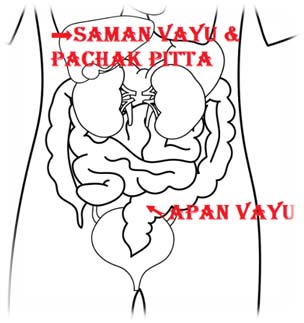
Saman Vayu is helpful to restore the digestive fire and helps digestion.
Pachakpitta also gets improved with Malasana as pachakpitta start metabolism of the food and strengthens the Agni (digestive fire).
Table of Contents
Relation with Dhatu:
Malasana strengthens Mansa Dhatu (muscle tissue) with Asthi Dhatu (bones).
Malasana specially acts on hips, sacral region and lower back. It also activates and tones the abdominal muscle while improving Agni (digestive fire) and digestion.
Relation with Malas:
Malasana helps to stretch the abdominal muscle and helps to strengthen abdominal organs including large intestine & rectum. Regulate the function of Apan Vayu which helps for proper excretion of feces, urine and is also helpful to prevent pregnant women from getting diabetic.
Relation with chakras:
Malasana is a good asana which balances the 1st and 2nd chakra i.e. Mooladhara and Swadhishtan chakra. Sacral and pelvic area included in Swadhishtan Chakra. After doing malasana pose it starts to flow the energy over Swadhishtan which governs flow of creativity, sexual & reproductive energy.
When the flow of energy coming below this Swadhishtan Chakra with sacral and rectal part with abdominal muscles flow energy to Mooladhara Chakra which relieves the constipation by eliminating waste products and also cleanses the body system.
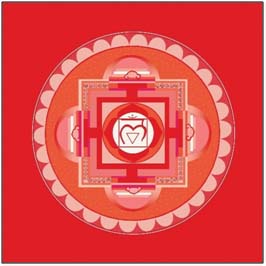
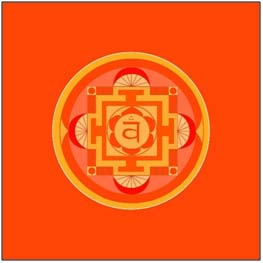
What does Malasana mean?
In Sanskrit Mala means mala (necklace) & waste product also.
Mala = necklace / waste
Asana = to sit / posture
So if you practice this pose of Malasana daily, you will never face the main issue of health which is constipation.
But at first if your culture doesn’t face this kind of activity on daily basis then this might seem weirder to you. BECAUSE in Indian tradition more specifically for eating meals, while defecating, while praying, while doing any kind of work, sitting on ground level, this pose is the first and comfortable choice.
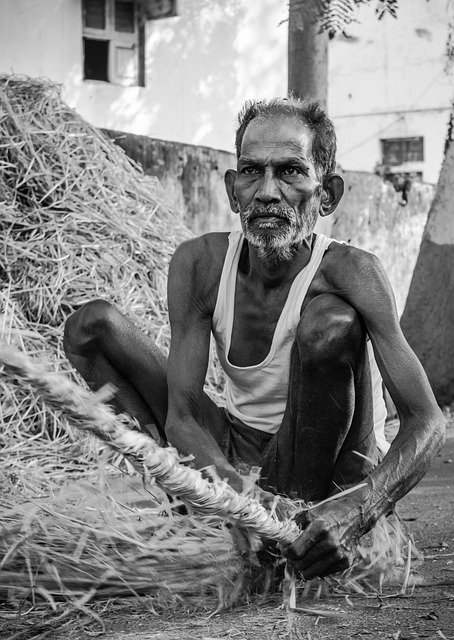
Are there any other variations with name?
UPVESASANA –
With namaste mudra which means performs asana in squatting position.
KANCHYASNA –
Golden belt pose. Feet are together with arm wrapped around the back while the chin touches the floor.
BHUJAPIDASANA–
The palms are place flat on the floor, arm stretch upright and the whole body is balancing on the hands, while the legs are held close to the body, with the legs are held close to the body, with heels hanging down from a position close to the shoulder with shoulder press.
What are the benefits of Malasana?
- Balances Apan Vayu (Relieves constipation, useful for urinary disorders and aphrodisiac).
- Strengthens pelvic portion.
- Relieves lower back pain.
- Improves hamstring strength.
- Improves posture.
- Strengthens Mansa Dhatu (Improves muscle tone)
- Balances saman Vayu and Pachak pitta (Improves digestion)
- Good for digestive disorders.
- Promotes energy.
- Helps to activate Swadhishtan and Mooladhara chakra.
- Increases flexibility of knees, ankles and groin.
- Helpful for PCOD and Endometriosis
- Helpful in pregnancy for natural delivery and manages gestational diabetes.
- Improves sleep.
- Improves psychological health
- Relives stress and negative feelings
- Helps to prevent hernia
- Enhances balance
- Relieves bone stiffness
- Helpful for aphrodisiac conditions
- Improves blood circulation
- Tones the abdominal muscle
- Keeps your pelvis and hips healthy
Who should not do this?
- Do not practice this pose if you have knee injury or lower back injury.
- Avoid if you recently had any kind of knee, lower back or abdominal surgery.
- Avoid if you have any ankle injury.
- Avoid Malasana if you have Hernia.
- During pregnancy get proper advice from your doctor or yoga instructor and only then do this pose.
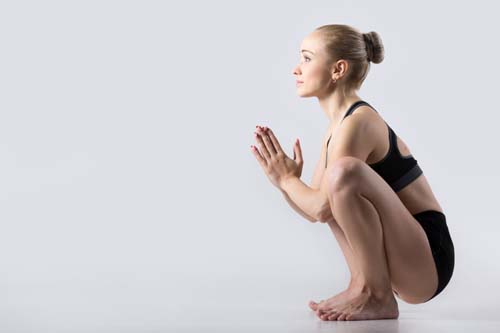
How to do Malasana?
- Begin in Tadasana (mountain pose) with your big toes touching and make a small space between your heel.
- You can keep your feet on edges of your yoga mat.
- Spread out your thigh, placing them slightly wider than your torso (central part of body / trunk).
- Extend your sternum away from your navel and broaded collarbone.
- Inhale and come into utkatasana (chair pose), reach until your fingertips to lengthen your torso while bending your knees and descending your tailbone.
- Press your shin (the front of leg below knee) to get back your more weight on your heels.
- Inhale and use your arms to find the length along your side body.
- Exhale and separate your knees while bending & pulling your palms down in front of your chest / heart which is called Namaste mudra.
- Lower your buttocks towards your heels and allow your pelvis gently spill and direct your tailbone to press your self towards ground level.
- Tilt your torso forward and spread your knees with the help of your elbows to inner your thigh. Open up the chest and lift your heart.
For a detailed explanation of how to do the Malasana yoga pose, watch this short interview of Miss Amita Bhagat from NewYork, USA. Amita is a LEVEL 2 CERTIFIED IYENGAR YOGA TEACHER and in this interview she demonstrates live how to perform the Malasana Yoga Pose.
In this short interview Dr. Pallavi Shinde from Pune, India asks her some pressing questions on this important yoga pose.
How to get heels down in Malasana pose?
Heels can’t go down because lack of flexibility in calves and lack of mobility in ankles, no flexibility in hips too.
So, to improvise mobility and flexibility is more important. And if you can’t do so you need to take a support with brick or blanket to do the pose in correct way.
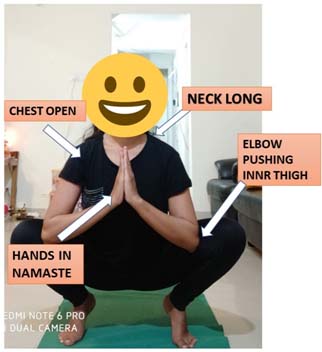
How long should you hold malasana pose?
Asana are meant to be hold for its benefits.
According to Yog sutras, you should hold the yoga poses for several minutes, which can be difficult and challenging for some poses. During traditional hatha yoga practice, duration of asana’s depending on master.
So the poses are held from 30 seconds to 5 minutes.
Is there any other variation with Malasana pose?
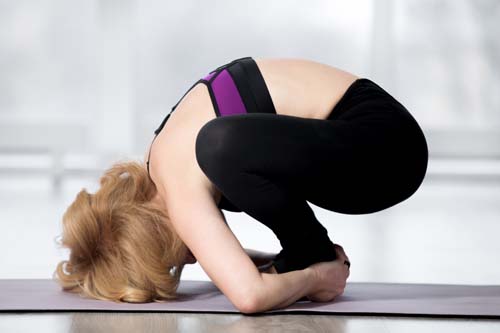
What is Malasana good for?
Malasana is helpful for colon and helps elimination of waste products. Malasana is good for strengthening the thigh muscle and pelvic muscle, gives good strength to the feet, ankle, hips, pelvis, calf muscles (hamstring) and spine.
Malasana is also good for the abdominal muscle and at the same time helpful for physical & mental wellbeing.
Can menstruating women do Malasana pose?
This is a fabulous pose you can do during your menstruation. The reason is, this is a hip opening and pelvic strengthening pose which relieves the menstrual cramps too.
NOTE: Do consult your Ayurveda Vaidya or yoga teacher before do this during menstruation.
Can I do Malasana during my pregnancy?
Yes malasana stretches the thighs, groin, ankle and pelvic portion it’s good for opening of pelvis so is useful during pregnancy.
During pregnancy women can suffer with lower back pain, constipation, and some mood behavior. This pose helps to relive constipation, relives back pain, improves posture, improves mood and stability.
NOTE: do consult your Ayurveda Vaidya or yoga teacher before do this during menstruation.
Reasons why I can’t do Malasana ?
Some people always feel that they can’t do this pose. The reason behind this could be posture deformity. There may be some problems with ankles, thighs or knees.
In Malasana, there is dorsiflexion of 35-40 degree so, while doing this your body may be indicating or resisting somewhere from ankles, tension of calves, hips opening or knee bending.
Tension in sacral region, tension in calves’ muscles and tension in knees can resist person to do malasana.
Can children do this pose ?
Yoga is a natural phenomenon happening in a child to make them stronger.
In young age muscles are ready to move faster and as per Ayurveda this is the age of kapha so, its good time to build the strength of child and flexibility. To reduce imbalance kapha, movements are very important which activates the vata.So, yoga poses are very helpful and best exercise for children.
What are some of the common obstacles in performing Malasana for the first time?
If you are doing this pose for the first time then you can face below issues:
- Heels do not touch to ground / unsteady
- Spine curved
- Tailbone tucked
- Knees can’t bend to much extent
- Chest closed
- Pelvic opening is not wider.
- Shoulders not open / shoulder down
- Chin down
Why is malasana or squatting pose better than sitting on a chair?
Sitting on a chair doesn’t move your muscle. While squatting improve muscle strength, moves your muscles, reduce health risk and also relieves constipation.
Should I try Malasana pose if I’m suffering from back or spine & knee disorders?
No Malasana is not good for the people who have knee or back injury. You should avoid this pose during knee and spine injury.
If I’m not able to sit in this pose can I take support from wall at back?
Yes, it’s a good way to take a support from wall or bricks or blankets to do malasana pose.
Pose can be eased and better with support.
For example., you can put blanket support below your heels or under hamstring muscle.
Is Malasana difficult to perform if I’m a short heighted person?
Not at all. There is no correlation of height while doing the malasana pose. Rather than I feel short person can do malasana pose better.
Are there any precautions before doing Malasana ?
Before starting Malasana make sure your stomach is empty. Take your meals 6-7 hours before you do the asana, so your food gets digested and you can do your body movements easily.
Which Yoga poses I must practice before I practice Malasana?
Before doing malasana pose it will be very helpful if you start some preparatory poses.
Purva – asana (preparatory poses):
- Baddha konasana
- Upvishta konasana
- Virasana
Paschat – asana (post – malasana pose)
- Adho-mukh shwanasana
- Uttanasana
- Bhujangasana
Does Malasana help reduce belly fat?
To reduce abdominal fat asanas are always helpful that move your gut nicely along with good digestion.
Malasana pose is helping to improve the digestion and even elimination of waste product form the body, at the same time, it cores the abdominal muscle.
Along with asanas, diet is also very important factor that you should consider.
Will performing Malasana give positive results if I’m suffering from constipation?
Yes, for sure. Will see this in anatomical way.
When we sit our colon naturally constrict as the weight of our torso pushes our thigh.
When we start to sit down or to stand up the chief muscles are legs and hip muscles. Especially quadriceps, hamstring and gluteus along with abdominal & other core muscle. Hip joint flex, joint bend so thighs move forward, knee flex and ankle dorsiflex.
Sitting in squatting position for defecation may be unhygienic or uncivilized, but sitting on western toilets can invite so many health issues with chronic constipation.
Point of conclusion:
Malasana is a grounding pose which connect you from theEarth element which always give us energy. Energy to live, energy to success, energy to think, energy to surrender, energy to be ready for all the troubles.
Malasana also improves concentration which improves your sadhana (devotion).
Ayurveda always says, beauty lies in malas (waste) of our body.
Keep your Malas healthy so you can naturally increase your beauty.

Image credits – People photo created by yanalya – www.freepik.com
Written By…
|
Dr. Pallavi Shinde is the director at Shree Vishwamukta Yog, Ayurved and Panchakarma Clinic at Pune, India. She always uses ayurvedic proprietary formulations for many chronic health diseases & many products for Skin Diseases & beauty products. She is a hardcore Researcher, Practitioner, Promoter of Ayurveda. Contact today to book an appointment. |
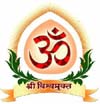
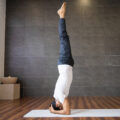
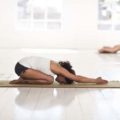


Excellent and exhaustive explanation of malasans, I found few times. I am doing this posture from long time.
I enjoyed this posture every time. Yes it’s have therapeutic aspects. You had covered all most.
Madam I am a yoga therapist following Iyengar ji .
I havebeen taken a case of paralysis of male age 56 years. He had astroke four months back.
Can you guide me how ayurveda and yoga help him to be recovered whatever’s possible.
I know yoga and Ayurveda both will give better results when combined together.
Thank you and regards
Pradeep sharma
Yoga therapist
9718340451
nirvrtayoga@gmail.com.
Namaste thank you so much for the reply. yes yoga and Ayurveda works hand-in-hand and when we combine this, the results are amazing.
for more details about your case of male person will elaborate Ayurveda treatment in mail.
thanks and regards.